Analyzing Lean Six Sigma and Total Quality Management in Healthcare
VerifiedAdded on 2023/05/30
|11
|2345
|318
Report
AI Summary
This report provides an overview of Lean Six Sigma (LSS) and Total Quality Management (TQM) in healthcare, discussing their pros, cons, and impact on patient care quality. LSS, a combination of Lean and Six Sigma methodologies, aims to improve performance by reducing variations and eliminating waste, leading to improved capacity utilization, reduced turnaround times, and enhanced patient satisfaction. However, LSS can be costly to implement and may not be suitable for smaller organizations. TQM, a systematic approach to organizational management, focuses on improving the quality of services and goods through internal practices. It offers benefits such as strengthened competitive positioning, higher productivity, and improved client focus, but may face challenges in implementation and cultural change. Both LSS and TQM have the potential to significantly enhance patient safety, reduce medical errors, and improve overall healthcare quality by optimizing processes and reducing unnecessary costs.
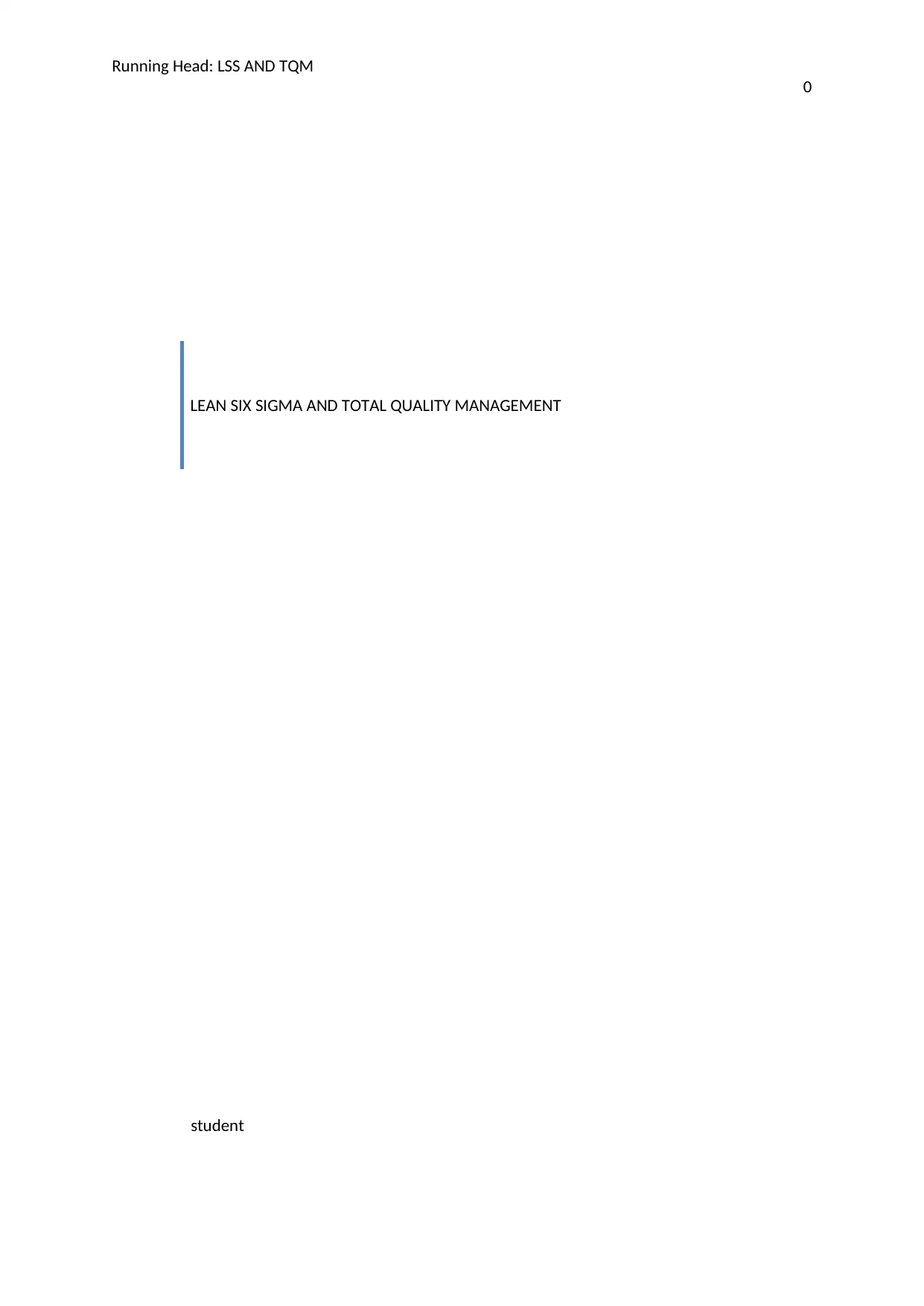
Running Head: LSS AND TQM
0
LEAN SIX SIGMA AND TOTAL QUALITY MANAGEMENT
student
0
LEAN SIX SIGMA AND TOTAL QUALITY MANAGEMENT
student
Paraphrase This Document
Need a fresh take? Get an instant paraphrase of this document with our AI Paraphraser

Running Head: LSS AND TQM
1
Lean Six Sigma
Overview
Lean six-sigma is considered as a method or strategy which depends on the team
efforts in order to improve the performance by reducing the variations and removing waste. It
is a combined strategy of two different process techniques: Lean and six-sigma (Pepper, &
Spedding, 2010). The cost for medical care is increasing day by day and ultimately impacts
the patients. Therefore the model like lean six-sigma needs to be implemented in healthcare
that helps the healthcare provides to reduce the cost and improves the services qualities. Lean
concentrate on waste elimination or reduction and six-sigma focuses on enhancing the
process quality and its efficiency (DelliFraine, Langabeer, & Nembhard, 2010). This
executive summary will discuss the pros and cons of the model and its impacts on quality at
the patient level.
Pros and cons
Lean six sigma model is beneficial to reduce the errors that may be caused by
techniques doctors or nurses at the hospital setting. It improves the capacity utilization,
improves quality, longer-term sustainability, improved turnaround time in the diagnostic labs,
it ultimately leads to improved patient/ customer satisfaction, and reduces the number of steps
in supply chains. It is also beneficial to make the reimbursements of insurance claim much
rapid (Delgado, Ferreira, & Castelo Branco, 2010). It generally focuses on simplifying health
care processes by gaining knowledge about eliminating waste and adding values. One of the
most important advantages of implementing lean six-sigma in an organization is that it
increases the employee involvement by enabling them to participate in the process
1
Lean Six Sigma
Overview
Lean six-sigma is considered as a method or strategy which depends on the team
efforts in order to improve the performance by reducing the variations and removing waste. It
is a combined strategy of two different process techniques: Lean and six-sigma (Pepper, &
Spedding, 2010). The cost for medical care is increasing day by day and ultimately impacts
the patients. Therefore the model like lean six-sigma needs to be implemented in healthcare
that helps the healthcare provides to reduce the cost and improves the services qualities. Lean
concentrate on waste elimination or reduction and six-sigma focuses on enhancing the
process quality and its efficiency (DelliFraine, Langabeer, & Nembhard, 2010). This
executive summary will discuss the pros and cons of the model and its impacts on quality at
the patient level.
Pros and cons
Lean six sigma model is beneficial to reduce the errors that may be caused by
techniques doctors or nurses at the hospital setting. It improves the capacity utilization,
improves quality, longer-term sustainability, improved turnaround time in the diagnostic labs,
it ultimately leads to improved patient/ customer satisfaction, and reduces the number of steps
in supply chains. It is also beneficial to make the reimbursements of insurance claim much
rapid (Delgado, Ferreira, & Castelo Branco, 2010). It generally focuses on simplifying health
care processes by gaining knowledge about eliminating waste and adding values. One of the
most important advantages of implementing lean six-sigma in an organization is that it
increases the employee involvement by enabling them to participate in the process
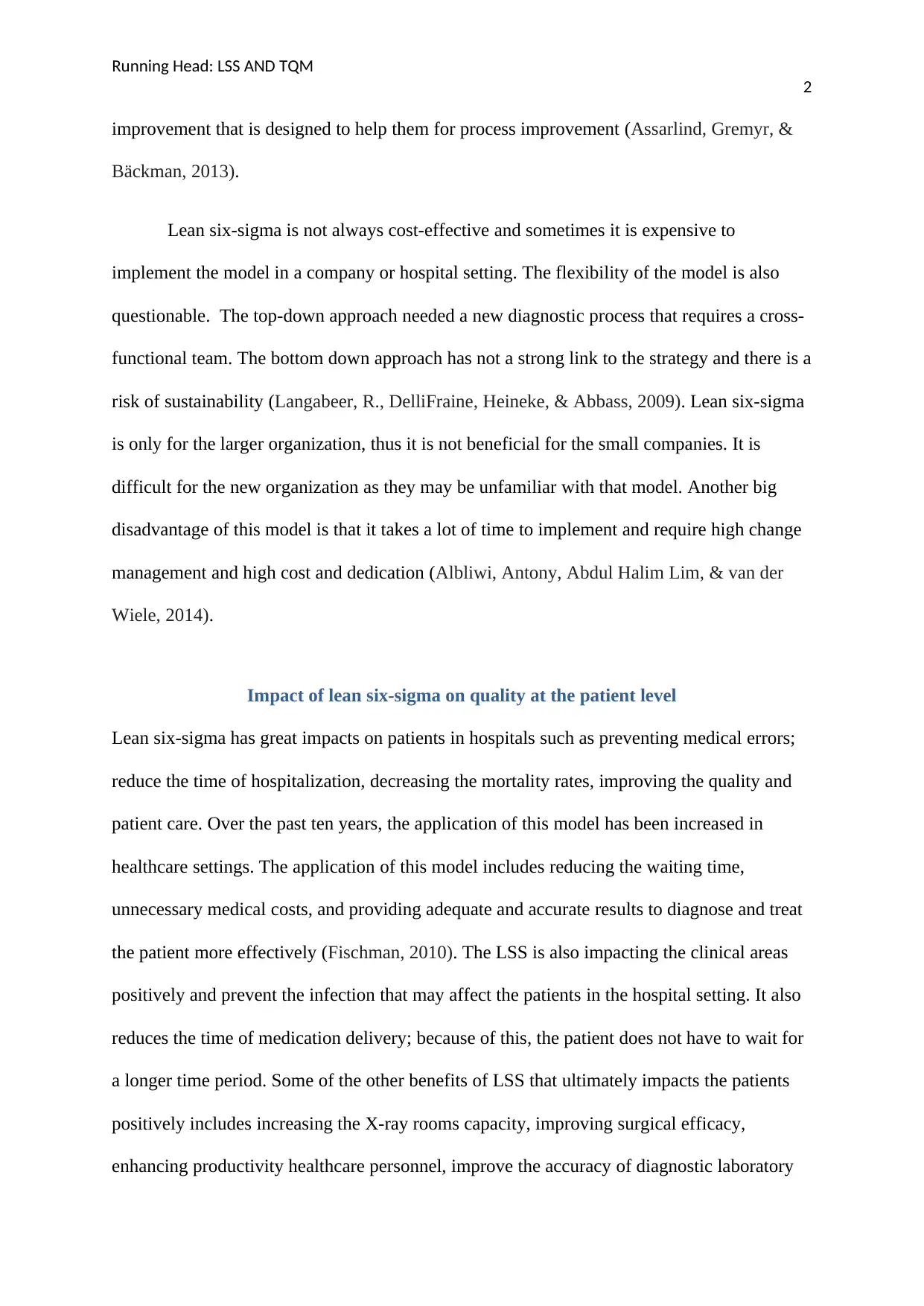
Running Head: LSS AND TQM
2
improvement that is designed to help them for process improvement (Assarlind, Gremyr, &
Bäckman, 2013).
Lean six-sigma is not always cost-effective and sometimes it is expensive to
implement the model in a company or hospital setting. The flexibility of the model is also
questionable. The top-down approach needed a new diagnostic process that requires a cross-
functional team. The bottom down approach has not a strong link to the strategy and there is a
risk of sustainability (Langabeer, R., DelliFraine, Heineke, & Abbass, 2009). Lean six-sigma
is only for the larger organization, thus it is not beneficial for the small companies. It is
difficult for the new organization as they may be unfamiliar with that model. Another big
disadvantage of this model is that it takes a lot of time to implement and require high change
management and high cost and dedication (Albliwi, Antony, Abdul Halim Lim, & van der
Wiele, 2014).
Impact of lean six-sigma on quality at the patient level
Lean six-sigma has great impacts on patients in hospitals such as preventing medical errors;
reduce the time of hospitalization, decreasing the mortality rates, improving the quality and
patient care. Over the past ten years, the application of this model has been increased in
healthcare settings. The application of this model includes reducing the waiting time,
unnecessary medical costs, and providing adequate and accurate results to diagnose and treat
the patient more effectively (Fischman, 2010). The LSS is also impacting the clinical areas
positively and prevent the infection that may affect the patients in the hospital setting. It also
reduces the time of medication delivery; because of this, the patient does not have to wait for
a longer time period. Some of the other benefits of LSS that ultimately impacts the patients
positively includes increasing the X-ray rooms capacity, improving surgical efficacy,
enhancing productivity healthcare personnel, improve the accuracy of diagnostic laboratory
2
improvement that is designed to help them for process improvement (Assarlind, Gremyr, &
Bäckman, 2013).
Lean six-sigma is not always cost-effective and sometimes it is expensive to
implement the model in a company or hospital setting. The flexibility of the model is also
questionable. The top-down approach needed a new diagnostic process that requires a cross-
functional team. The bottom down approach has not a strong link to the strategy and there is a
risk of sustainability (Langabeer, R., DelliFraine, Heineke, & Abbass, 2009). Lean six-sigma
is only for the larger organization, thus it is not beneficial for the small companies. It is
difficult for the new organization as they may be unfamiliar with that model. Another big
disadvantage of this model is that it takes a lot of time to implement and require high change
management and high cost and dedication (Albliwi, Antony, Abdul Halim Lim, & van der
Wiele, 2014).
Impact of lean six-sigma on quality at the patient level
Lean six-sigma has great impacts on patients in hospitals such as preventing medical errors;
reduce the time of hospitalization, decreasing the mortality rates, improving the quality and
patient care. Over the past ten years, the application of this model has been increased in
healthcare settings. The application of this model includes reducing the waiting time,
unnecessary medical costs, and providing adequate and accurate results to diagnose and treat
the patient more effectively (Fischman, 2010). The LSS is also impacting the clinical areas
positively and prevent the infection that may affect the patients in the hospital setting. It also
reduces the time of medication delivery; because of this, the patient does not have to wait for
a longer time period. Some of the other benefits of LSS that ultimately impacts the patients
positively includes increasing the X-ray rooms capacity, improving surgical efficacy,
enhancing productivity healthcare personnel, improve the accuracy of diagnostic laboratory
⊘ This is a preview!⊘
Do you want full access?
Subscribe today to unlock all pages.

Trusted by 1+ million students worldwide
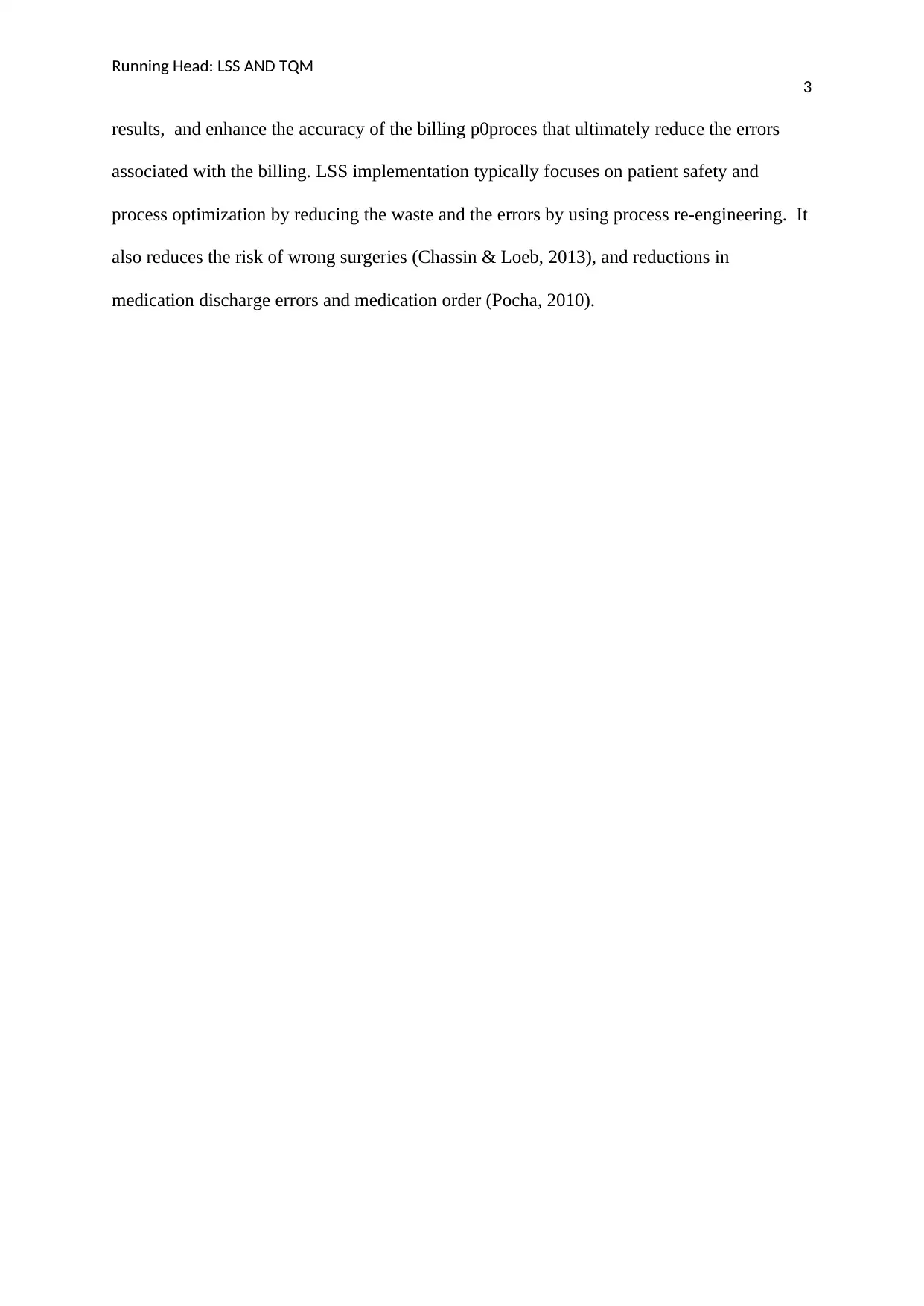
Running Head: LSS AND TQM
3
results, and enhance the accuracy of the billing p0proces that ultimately reduce the errors
associated with the billing. LSS implementation typically focuses on patient safety and
process optimization by reducing the waste and the errors by using process re-engineering. It
also reduces the risk of wrong surgeries (Chassin & Loeb, 2013), and reductions in
medication discharge errors and medication order (Pocha, 2010).
3
results, and enhance the accuracy of the billing p0proces that ultimately reduce the errors
associated with the billing. LSS implementation typically focuses on patient safety and
process optimization by reducing the waste and the errors by using process re-engineering. It
also reduces the risk of wrong surgeries (Chassin & Loeb, 2013), and reductions in
medication discharge errors and medication order (Pocha, 2010).
Paraphrase This Document
Need a fresh take? Get an instant paraphrase of this document with our AI Paraphraser
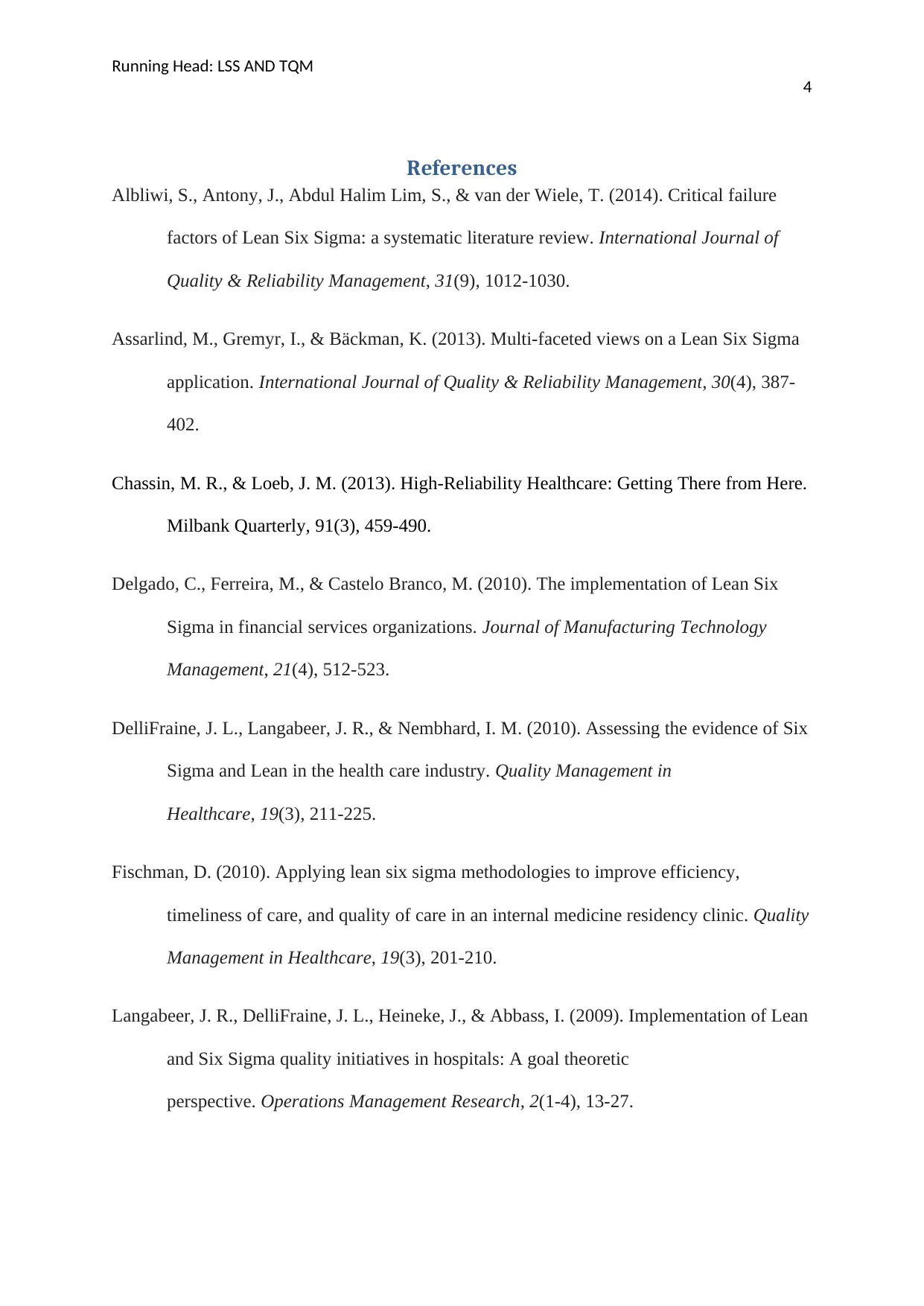
Running Head: LSS AND TQM
4
References
Albliwi, S., Antony, J., Abdul Halim Lim, S., & van der Wiele, T. (2014). Critical failure
factors of Lean Six Sigma: a systematic literature review. International Journal of
Quality & Reliability Management, 31(9), 1012-1030.
Assarlind, M., Gremyr, I., & Bäckman, K. (2013). Multi-faceted views on a Lean Six Sigma
application. International Journal of Quality & Reliability Management, 30(4), 387-
402.
Chassin, M. R., & Loeb, J. M. (2013). High-Reliability Healthcare: Getting There from Here.
Milbank Quarterly, 91(3), 459-490.
Delgado, C., Ferreira, M., & Castelo Branco, M. (2010). The implementation of Lean Six
Sigma in financial services organizations. Journal of Manufacturing Technology
Management, 21(4), 512-523.
DelliFraine, J. L., Langabeer, J. R., & Nembhard, I. M. (2010). Assessing the evidence of Six
Sigma and Lean in the health care industry. Quality Management in
Healthcare, 19(3), 211-225.
Fischman, D. (2010). Applying lean six sigma methodologies to improve efficiency,
timeliness of care, and quality of care in an internal medicine residency clinic. Quality
Management in Healthcare, 19(3), 201-210.
Langabeer, J. R., DelliFraine, J. L., Heineke, J., & Abbass, I. (2009). Implementation of Lean
and Six Sigma quality initiatives in hospitals: A goal theoretic
perspective. Operations Management Research, 2(1-4), 13-27.
4
References
Albliwi, S., Antony, J., Abdul Halim Lim, S., & van der Wiele, T. (2014). Critical failure
factors of Lean Six Sigma: a systematic literature review. International Journal of
Quality & Reliability Management, 31(9), 1012-1030.
Assarlind, M., Gremyr, I., & Bäckman, K. (2013). Multi-faceted views on a Lean Six Sigma
application. International Journal of Quality & Reliability Management, 30(4), 387-
402.
Chassin, M. R., & Loeb, J. M. (2013). High-Reliability Healthcare: Getting There from Here.
Milbank Quarterly, 91(3), 459-490.
Delgado, C., Ferreira, M., & Castelo Branco, M. (2010). The implementation of Lean Six
Sigma in financial services organizations. Journal of Manufacturing Technology
Management, 21(4), 512-523.
DelliFraine, J. L., Langabeer, J. R., & Nembhard, I. M. (2010). Assessing the evidence of Six
Sigma and Lean in the health care industry. Quality Management in
Healthcare, 19(3), 211-225.
Fischman, D. (2010). Applying lean six sigma methodologies to improve efficiency,
timeliness of care, and quality of care in an internal medicine residency clinic. Quality
Management in Healthcare, 19(3), 201-210.
Langabeer, J. R., DelliFraine, J. L., Heineke, J., & Abbass, I. (2009). Implementation of Lean
and Six Sigma quality initiatives in hospitals: A goal theoretic
perspective. Operations Management Research, 2(1-4), 13-27.

Running Head: LSS AND TQM
5
Pepper, M. P., & Spedding, T. A. (2010). The evolution of Lean Six Sigma. International
Journal of Quality & Reliability Management, 27(2), 138-155.
Pocha, C. (2010). Lean Six Sigma in Healthcare and the Challenge of Implementation of Six
Sigma Methodologies at a Veterans Affairs Medical Center. Quality Management in
Healthcare, 19(4), 312-318.
5
Pepper, M. P., & Spedding, T. A. (2010). The evolution of Lean Six Sigma. International
Journal of Quality & Reliability Management, 27(2), 138-155.
Pocha, C. (2010). Lean Six Sigma in Healthcare and the Challenge of Implementation of Six
Sigma Methodologies at a Veterans Affairs Medical Center. Quality Management in
Healthcare, 19(4), 312-318.
⊘ This is a preview!⊘
Do you want full access?
Subscribe today to unlock all pages.

Trusted by 1+ million students worldwide

Running Head: LSS AND TQM
6
Total Quality Management
Overview
Total quality management or TQM is the systematic and structural approach for
organizational management that specifically focuses on the improvements of the quality of a
company's output such as services and goods by improving the internal practices (Hoang,
Igel, & Laosirihongthong, 2010). It was developed by a management consultant named
William Deming. This approach is more similar to the six sigma improvement process. TQM
is considered as the continual method of identifying and decreasing or eliminating the
customer experience and enable the employees to speed with the training. Quality
management has become noticeable issues in the healthcare organizations that need to be
eradicated or reduced. TQM focuses on continues quality improvement, customer focus and
teamwork (Hur, 2009). In this particular executive summary, the pros and cons and impacts
of this model on quality of patient level will be discussed.
Pros and cons of Total quality management
There are number of benefits o implementing the TQM model in an organization and
healthcare setting such as strengthening competitive position, higher productivity, enhanced
market image, adaptability to emerging the market conditions and to the environment,
eradication of waste and defects, decreased costs and better management of cost, improved
client focus and satisfaction, higher profitability, increased job security, higher customer
retention and loyalty, increased employee morale, improved stakeholder and shareholder
value, and enhanced and innovative process. Implementing TQM results in better product
manufacturing and very low cost. It concentrates on applying the high-quality data or
information to enhance the process to decrease the waste and save time, this ultimately leads
6
Total Quality Management
Overview
Total quality management or TQM is the systematic and structural approach for
organizational management that specifically focuses on the improvements of the quality of a
company's output such as services and goods by improving the internal practices (Hoang,
Igel, & Laosirihongthong, 2010). It was developed by a management consultant named
William Deming. This approach is more similar to the six sigma improvement process. TQM
is considered as the continual method of identifying and decreasing or eliminating the
customer experience and enable the employees to speed with the training. Quality
management has become noticeable issues in the healthcare organizations that need to be
eradicated or reduced. TQM focuses on continues quality improvement, customer focus and
teamwork (Hur, 2009). In this particular executive summary, the pros and cons and impacts
of this model on quality of patient level will be discussed.
Pros and cons of Total quality management
There are number of benefits o implementing the TQM model in an organization and
healthcare setting such as strengthening competitive position, higher productivity, enhanced
market image, adaptability to emerging the market conditions and to the environment,
eradication of waste and defects, decreased costs and better management of cost, improved
client focus and satisfaction, higher profitability, increased job security, higher customer
retention and loyalty, increased employee morale, improved stakeholder and shareholder
value, and enhanced and innovative process. Implementing TQM results in better product
manufacturing and very low cost. It concentrates on applying the high-quality data or
information to enhance the process to decrease the waste and save time, this ultimately leads
Paraphrase This Document
Need a fresh take? Get an instant paraphrase of this document with our AI Paraphraser
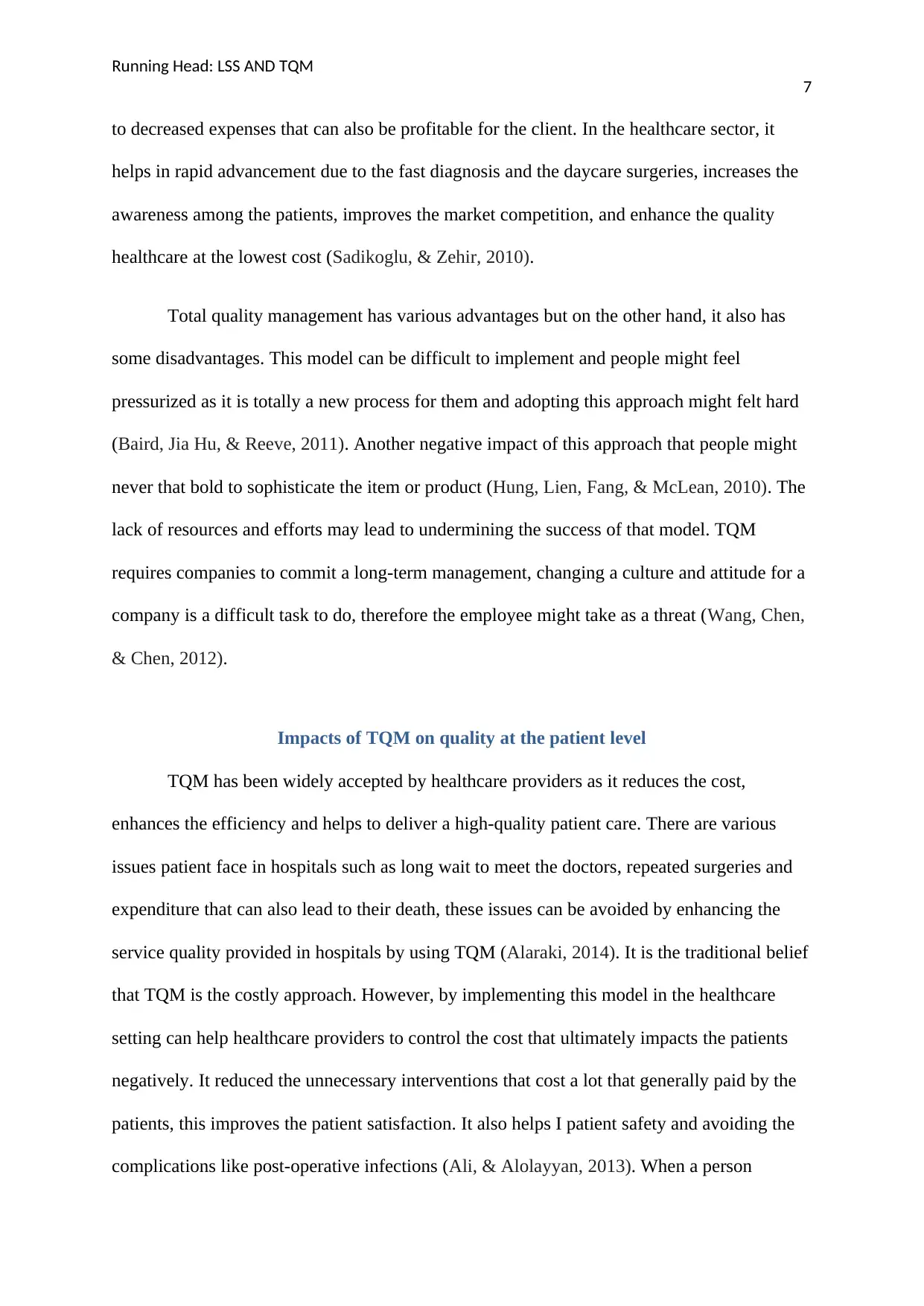
Running Head: LSS AND TQM
7
to decreased expenses that can also be profitable for the client. In the healthcare sector, it
helps in rapid advancement due to the fast diagnosis and the daycare surgeries, increases the
awareness among the patients, improves the market competition, and enhance the quality
healthcare at the lowest cost (Sadikoglu, & Zehir, 2010).
Total quality management has various advantages but on the other hand, it also has
some disadvantages. This model can be difficult to implement and people might feel
pressurized as it is totally a new process for them and adopting this approach might felt hard
(Baird, Jia Hu, & Reeve, 2011). Another negative impact of this approach that people might
never that bold to sophisticate the item or product (Hung, Lien, Fang, & McLean, 2010). The
lack of resources and efforts may lead to undermining the success of that model. TQM
requires companies to commit a long-term management, changing a culture and attitude for a
company is a difficult task to do, therefore the employee might take as a threat (Wang, Chen,
& Chen, 2012).
Impacts of TQM on quality at the patient level
TQM has been widely accepted by healthcare providers as it reduces the cost,
enhances the efficiency and helps to deliver a high-quality patient care. There are various
issues patient face in hospitals such as long wait to meet the doctors, repeated surgeries and
expenditure that can also lead to their death, these issues can be avoided by enhancing the
service quality provided in hospitals by using TQM (Alaraki, 2014). It is the traditional belief
that TQM is the costly approach. However, by implementing this model in the healthcare
setting can help healthcare providers to control the cost that ultimately impacts the patients
negatively. It reduced the unnecessary interventions that cost a lot that generally paid by the
patients, this improves the patient satisfaction. It also helps I patient safety and avoiding the
complications like post-operative infections (Ali, & Alolayyan, 2013). When a person
7
to decreased expenses that can also be profitable for the client. In the healthcare sector, it
helps in rapid advancement due to the fast diagnosis and the daycare surgeries, increases the
awareness among the patients, improves the market competition, and enhance the quality
healthcare at the lowest cost (Sadikoglu, & Zehir, 2010).
Total quality management has various advantages but on the other hand, it also has
some disadvantages. This model can be difficult to implement and people might feel
pressurized as it is totally a new process for them and adopting this approach might felt hard
(Baird, Jia Hu, & Reeve, 2011). Another negative impact of this approach that people might
never that bold to sophisticate the item or product (Hung, Lien, Fang, & McLean, 2010). The
lack of resources and efforts may lead to undermining the success of that model. TQM
requires companies to commit a long-term management, changing a culture and attitude for a
company is a difficult task to do, therefore the employee might take as a threat (Wang, Chen,
& Chen, 2012).
Impacts of TQM on quality at the patient level
TQM has been widely accepted by healthcare providers as it reduces the cost,
enhances the efficiency and helps to deliver a high-quality patient care. There are various
issues patient face in hospitals such as long wait to meet the doctors, repeated surgeries and
expenditure that can also lead to their death, these issues can be avoided by enhancing the
service quality provided in hospitals by using TQM (Alaraki, 2014). It is the traditional belief
that TQM is the costly approach. However, by implementing this model in the healthcare
setting can help healthcare providers to control the cost that ultimately impacts the patients
negatively. It reduced the unnecessary interventions that cost a lot that generally paid by the
patients, this improves the patient satisfaction. It also helps I patient safety and avoiding the
complications like post-operative infections (Ali, & Alolayyan, 2013). When a person
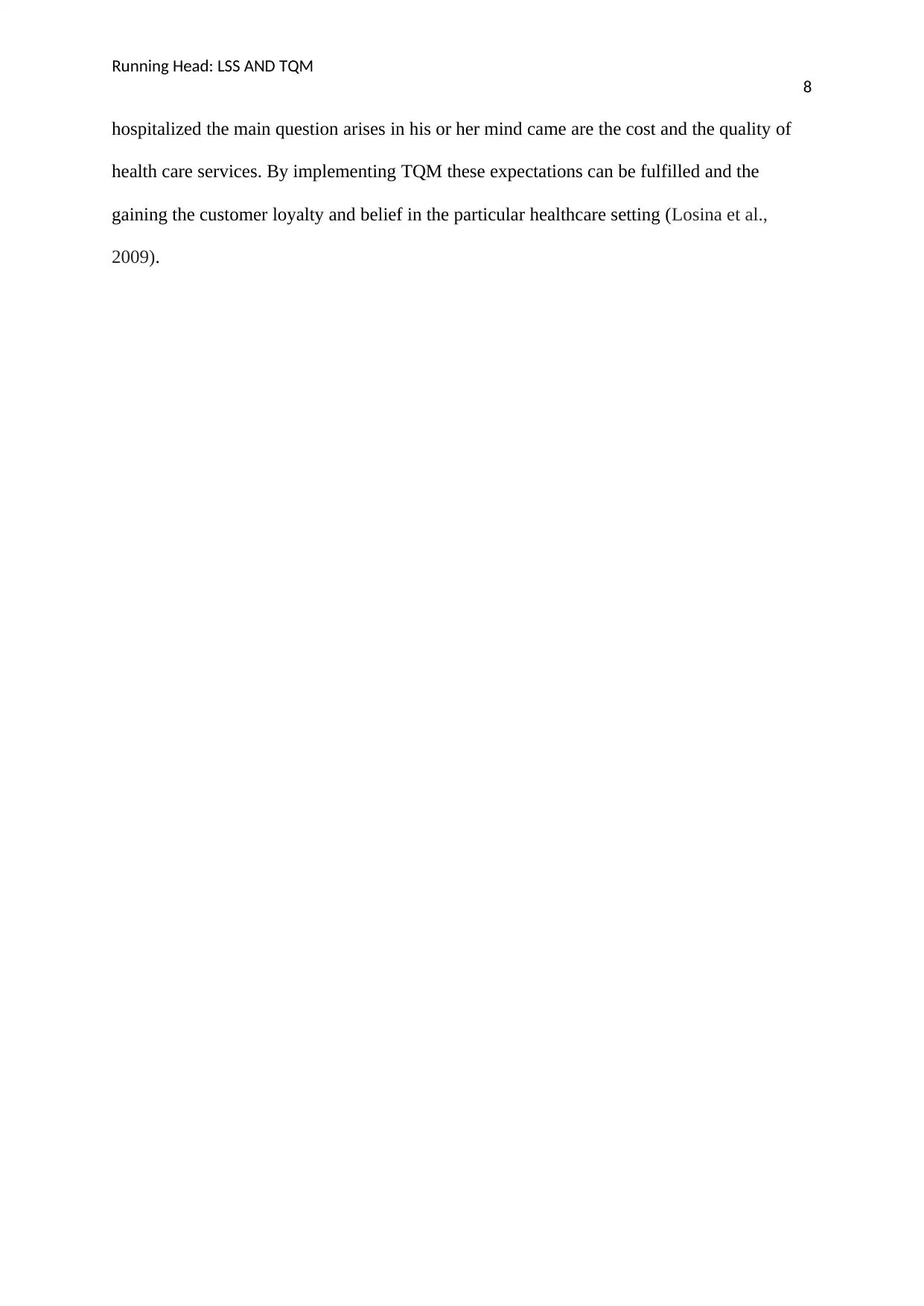
Running Head: LSS AND TQM
8
hospitalized the main question arises in his or her mind came are the cost and the quality of
health care services. By implementing TQM these expectations can be fulfilled and the
gaining the customer loyalty and belief in the particular healthcare setting (Losina et al.,
2009).
8
hospitalized the main question arises in his or her mind came are the cost and the quality of
health care services. By implementing TQM these expectations can be fulfilled and the
gaining the customer loyalty and belief in the particular healthcare setting (Losina et al.,
2009).
⊘ This is a preview!⊘
Do you want full access?
Subscribe today to unlock all pages.

Trusted by 1+ million students worldwide

Running Head: LSS AND TQM
9
References
Alaraki, M. S. (2014). The impact of critical total quality management practices on hospital
performance in the ministry of health hospitals in Saudi Arabia. Quality Management
in Healthcare, 23(1), 59-63.
Ali, K. A. M., & Alolayyan, M. N. (2013). The impact of total quality management (TQM)
on the hospital’s performance: an empirical research. International Journal of
Services and Operations Management, 15(4), 482-506.
Baird, K., Jia Hu, K., & Reeve, R. (2011). The relationships between organizational culture,
total quality management practices, and operational performance. International
Journal of Operations & Production Management, 31(7), 789-814.
Hoang, D. T., Igel, B., & Laosirihongthong, T. (2010). Total quality management (TQM)
strategy and organizational characteristics: Evidence from a recent WTO
member. Total quality management, 21(9), 931-951.
Hung, R. Y. Y., Lien, B. Y. H., Fang, S. C., & McLean, G. N. (2010). Knowledge as a
facilitator for enhancing innovation performance through total quality
management. Total Quality Management, 21(4), 425-438.
Hur, M. H. (2009). The influence of total quality management practices on the transformation
of how organizations work. Total Quality Management, 20(8), 847-861.
Losina, E., Walensky, R. P., Kessler, C. L., Emrani, P. S., Reichmann, W. M., Wright, E.
A., ... & Katz, J. N. (2009). Cost-effectiveness of total knee arthroplasty in the United
States: patient risk and hospital volume. Archives of internal medicine, 169(12), 1113.
9
References
Alaraki, M. S. (2014). The impact of critical total quality management practices on hospital
performance in the ministry of health hospitals in Saudi Arabia. Quality Management
in Healthcare, 23(1), 59-63.
Ali, K. A. M., & Alolayyan, M. N. (2013). The impact of total quality management (TQM)
on the hospital’s performance: an empirical research. International Journal of
Services and Operations Management, 15(4), 482-506.
Baird, K., Jia Hu, K., & Reeve, R. (2011). The relationships between organizational culture,
total quality management practices, and operational performance. International
Journal of Operations & Production Management, 31(7), 789-814.
Hoang, D. T., Igel, B., & Laosirihongthong, T. (2010). Total quality management (TQM)
strategy and organizational characteristics: Evidence from a recent WTO
member. Total quality management, 21(9), 931-951.
Hung, R. Y. Y., Lien, B. Y. H., Fang, S. C., & McLean, G. N. (2010). Knowledge as a
facilitator for enhancing innovation performance through total quality
management. Total Quality Management, 21(4), 425-438.
Hur, M. H. (2009). The influence of total quality management practices on the transformation
of how organizations work. Total Quality Management, 20(8), 847-861.
Losina, E., Walensky, R. P., Kessler, C. L., Emrani, P. S., Reichmann, W. M., Wright, E.
A., ... & Katz, J. N. (2009). Cost-effectiveness of total knee arthroplasty in the United
States: patient risk and hospital volume. Archives of internal medicine, 169(12), 1113.
Paraphrase This Document
Need a fresh take? Get an instant paraphrase of this document with our AI Paraphraser
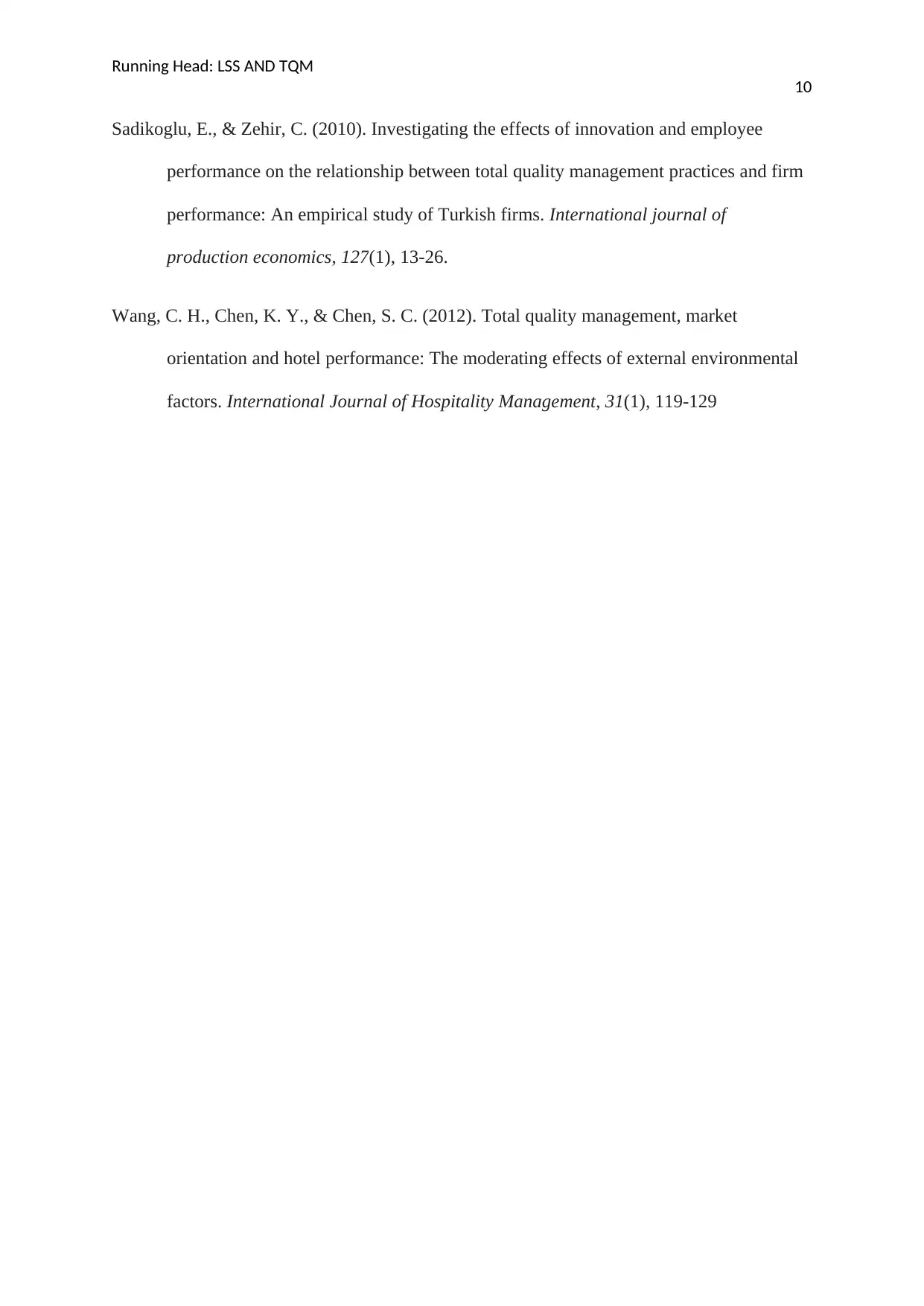
Running Head: LSS AND TQM
10
Sadikoglu, E., & Zehir, C. (2010). Investigating the effects of innovation and employee
performance on the relationship between total quality management practices and firm
performance: An empirical study of Turkish firms. International journal of
production economics, 127(1), 13-26.
Wang, C. H., Chen, K. Y., & Chen, S. C. (2012). Total quality management, market
orientation and hotel performance: The moderating effects of external environmental
factors. International Journal of Hospitality Management, 31(1), 119-129
10
Sadikoglu, E., & Zehir, C. (2010). Investigating the effects of innovation and employee
performance on the relationship between total quality management practices and firm
performance: An empirical study of Turkish firms. International journal of
production economics, 127(1), 13-26.
Wang, C. H., Chen, K. Y., & Chen, S. C. (2012). Total quality management, market
orientation and hotel performance: The moderating effects of external environmental
factors. International Journal of Hospitality Management, 31(1), 119-129
1 out of 11
Related Documents
Your All-in-One AI-Powered Toolkit for Academic Success.
+13062052269
info@desklib.com
Available 24*7 on WhatsApp / Email
![[object Object]](/_next/static/media/star-bottom.7253800d.svg)
Unlock your academic potential
Copyright © 2020–2025 A2Z Services. All Rights Reserved. Developed and managed by ZUCOL.





